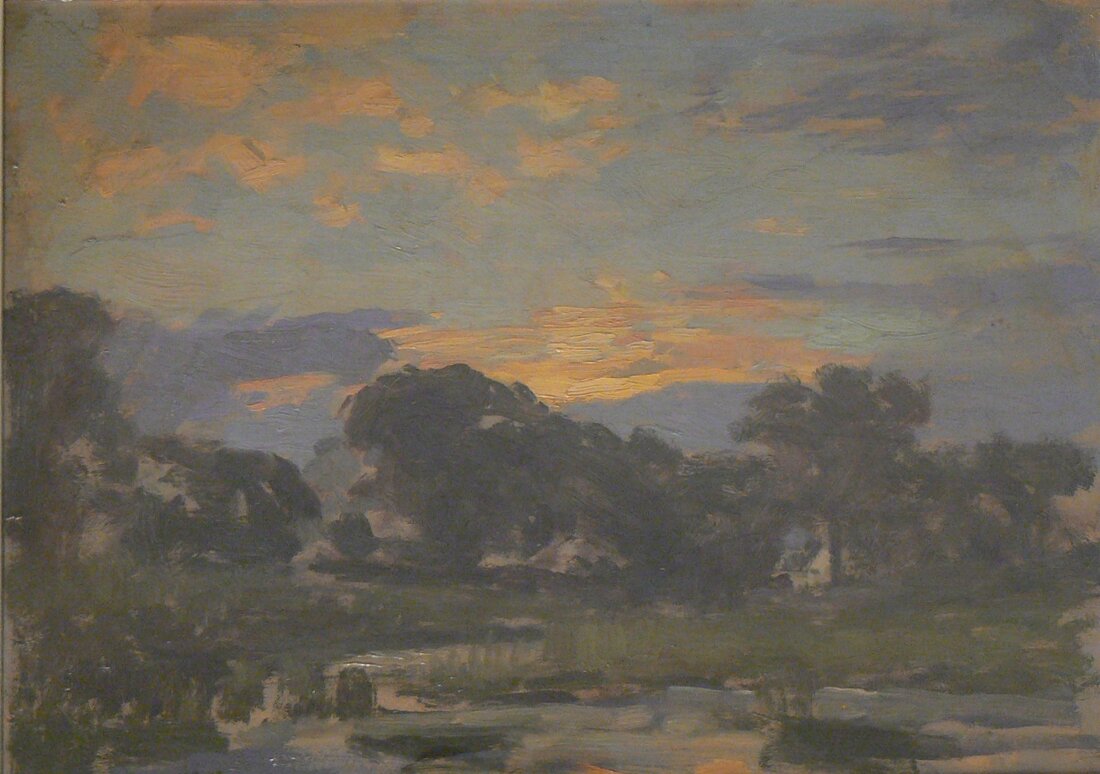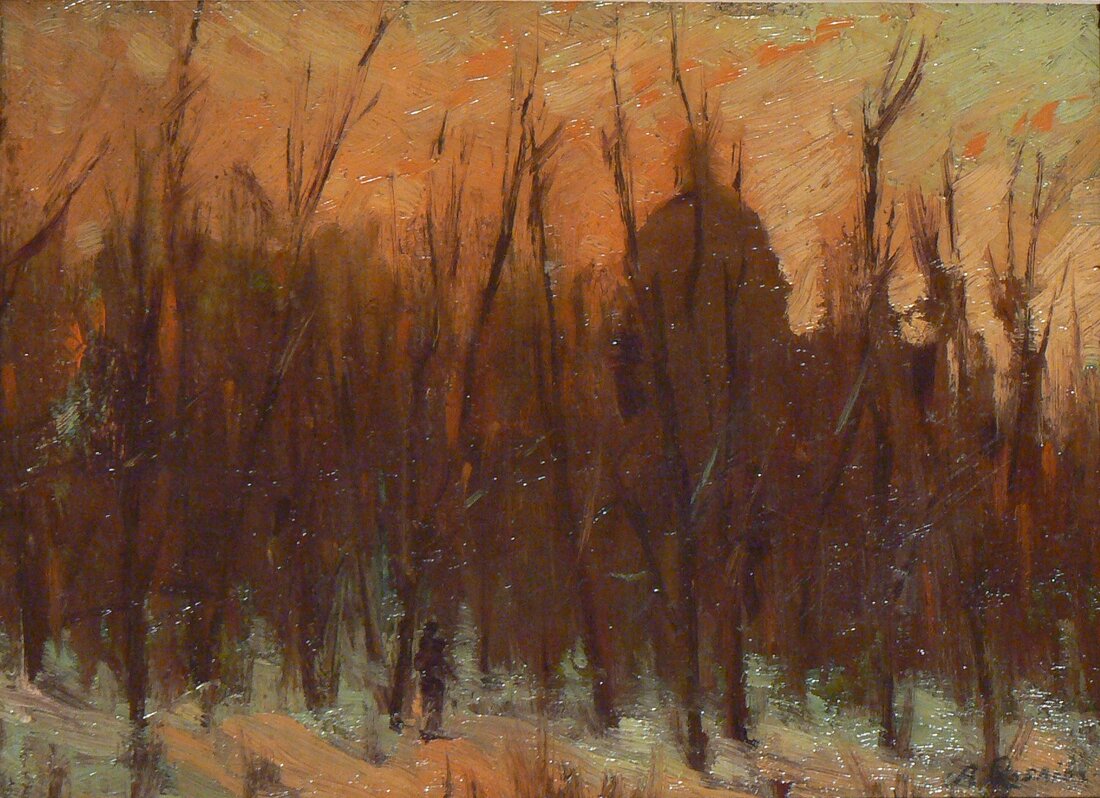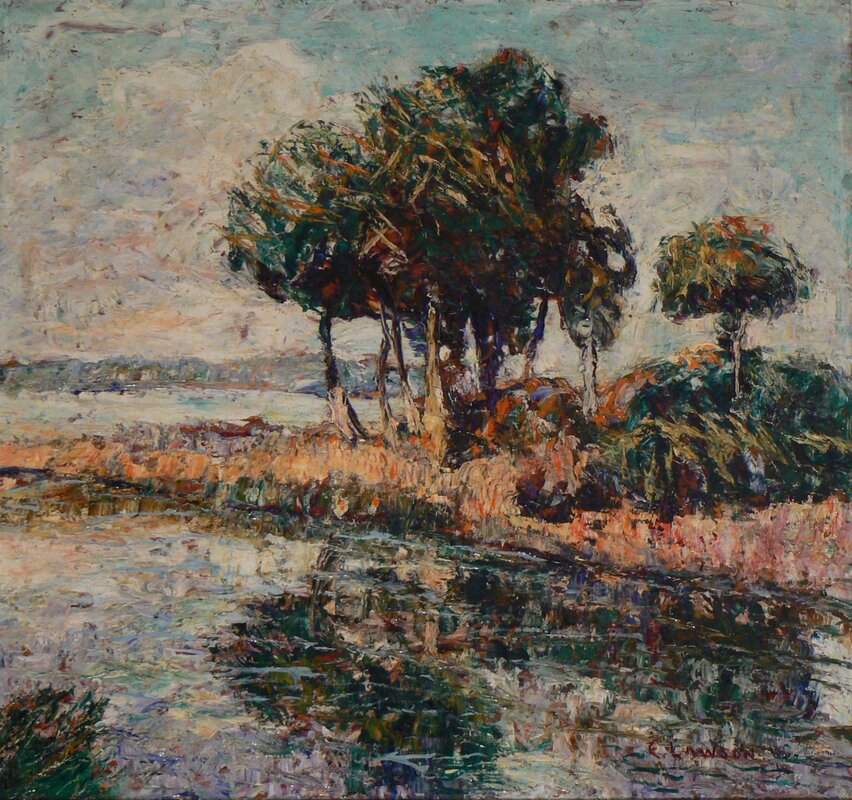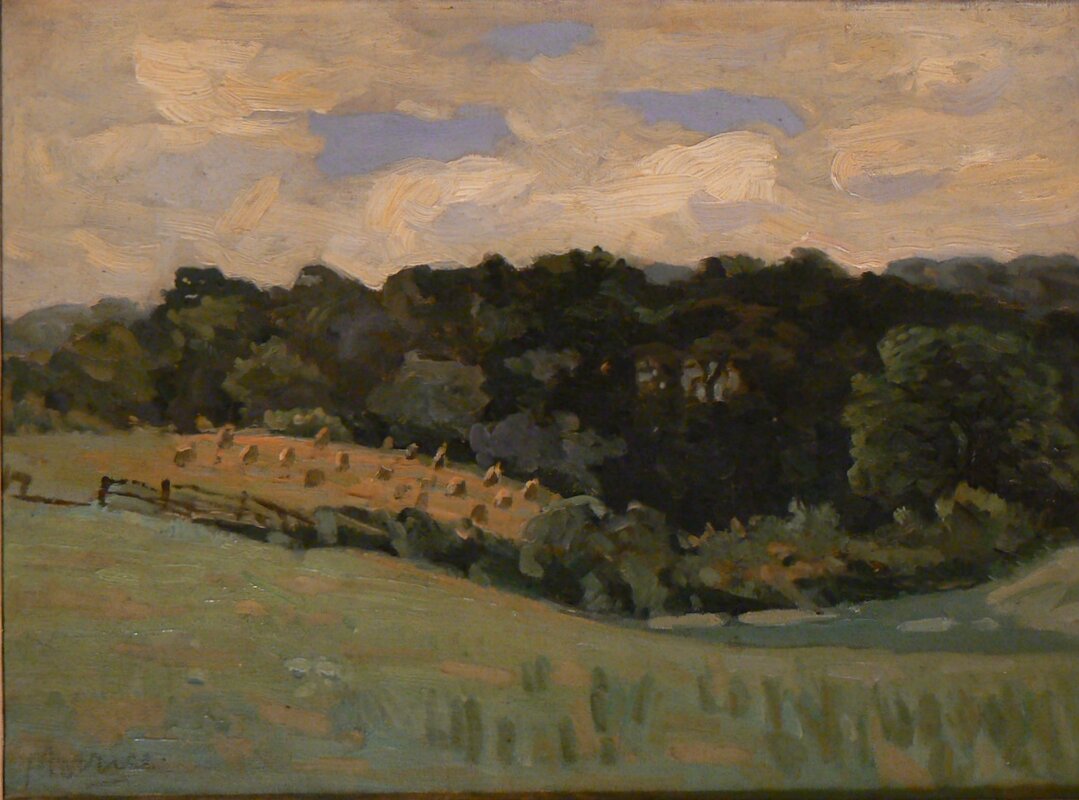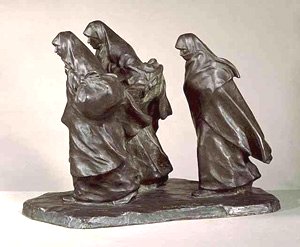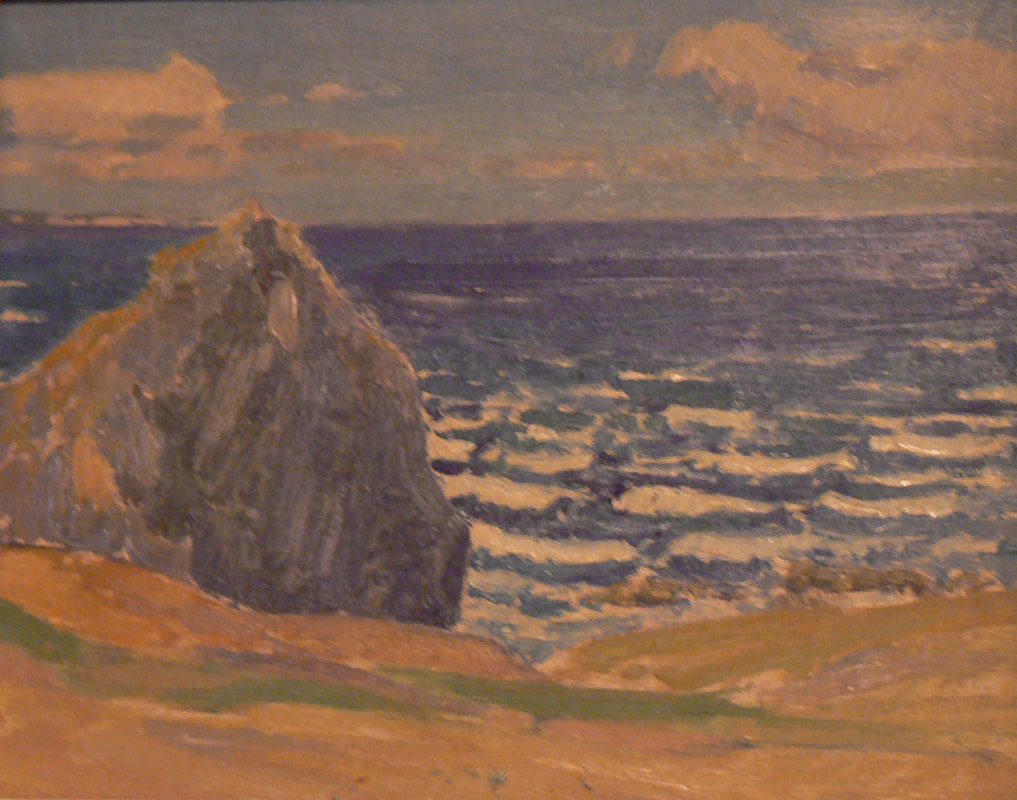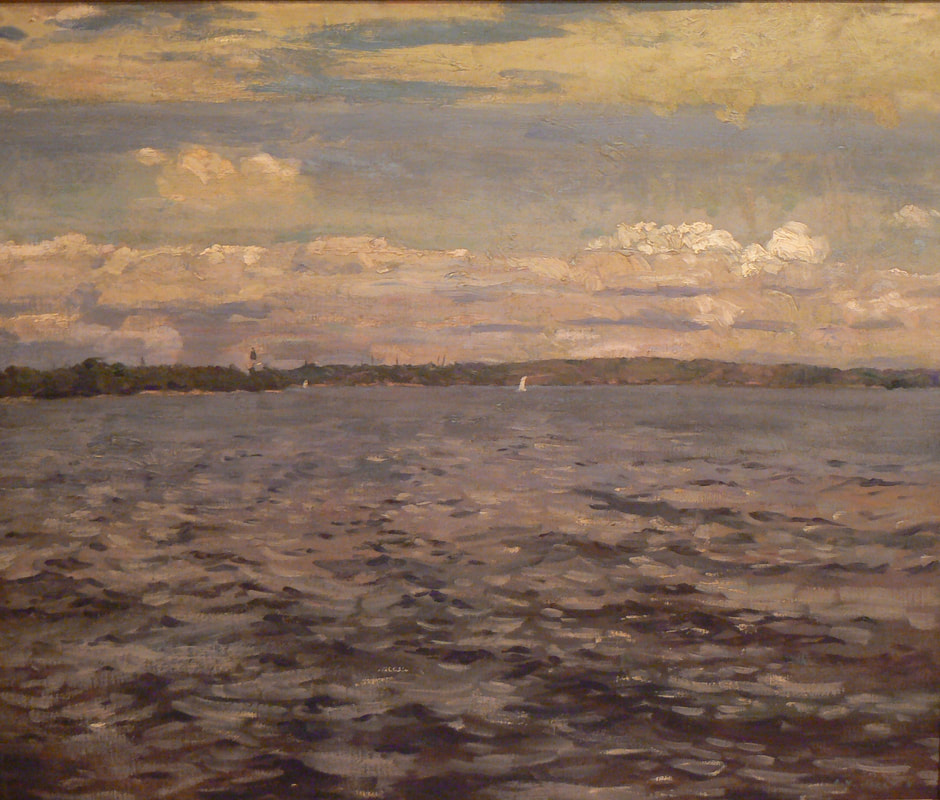Canadian Impressionism
Curated by Debra Antoncic
|
Marc-Aurèle de Foy Suzor-Coté
b. Victoriaville QC 1869, d. 1937 Daytona Beach SON OF THE PIONEER, 1921 Oil on canvas Rendered in the light palette and rough gestural brushstrokes associated with impressionism, this portrait of the artist’s nephew, Jacques Gerrard Poisson, is given a gloss of French-Canadian nationalism through the title. The portrait dates to the the early 1920s, when folklorists and anthropologists in Québec began to record oral traditions and folksongs and collected objects from rural communities. The pioneer (habitant) was valorized amid concerns the old ways were vanishing. While French impressionists captured the denizens of the city and the public spaces of modernity, Suzor applied the lessons of impressionism to traditional subjects in French Canada. Marc-Aurèle de Foy Suzor-Coté was born in Arthabaska (Victoriaville, Québec). After studying with painter-decorator Joseph-Thomas Rousseau, Suzor left Québec for Paris to complete his training at the École des Beaux-Arts. He also studied with Henri Harpignies, a landscape artist working in the Barbizon style, who introduced him to painting en plein air. By the early 1900s Suzor’s painting displayed the impact of impressionism in his use of a bright palette and freely applied brush strokes. Suzor returned to Canada in 1907, his training complete. Through family contacts with Wilfrid Laurier, Suzor was granted commissions that launched his career as a painter in Canada. He was a versatile artist who also drew and sculpted, produced portraits and book illustrations, history paintings and female nudes. In 1927, Suzor suffered a stroke and became paralyzed. He moved to Daytona Beach, Florida, where he gradually began drawing, sculpting and painting again. He died in Daytona Beach in 1937. |
|
William Brymner
b. Greenoch, Scotland 1855, d. 1925 Wallasey, Cheshire, England EVENING SHADOWS, n.d Oil on wood panel While not considered a practitioner of impressionism, William Brymner painted directly from nature in the style of the French Barbizon school, an important influence on the French impressionists. This group of painters explored the rural landscape outside of Paris, seeking recognition that landscape was a viable subject in its own right. Born in Greenock, Scotland, Brymner moved to Canada with his family in 1857 and grew up in the Ottawa area where his father worked as the Dominion Archivist. Following architectural studies Brymner enrolled at the Académie Julian in Paris, France in 1878 where his instructors were William-Adolphe Bouguereau and Tony Robert-Fleury. William Brymner was an influential art teacher and painter of figures and landscapes. He settled in Montreal in 1886, where he taught for thirty-five years at the Art Association of Montreal. Among his students were painters A.Y. Jackson and Clarence Gagnon. |
|
Arthur-Dominique Rozaire (also Rosaire)
b. 1879 Montreal, d. Los Angeles 1922 SUNSET, MOUNT ROYAL, MONTREAL, n.d. Oil on wood panel In the early decades of the 20th century, while Anglo-Canadian artists explored the Canadian wilderness, Québec painters such as Rosaire looked to settled communities for their subjects. In this view of Mount Royal in Montreal, the horizontal screen of trees is a prominent feature, but the dome of a building in the background points to the proximity of the city. This preference was sustained by patronage from the Catholic Church and supported by Catholic teachings at the time. According to Church doctrine, wilderness evoked the expulsion from Garden of Eden and the temptation of Christ. A settled landscape, however, proclaimed a deeply rooted French Canadian presence in the land. Arthur Rosaire (also Rozaire) was born in Montreal in 1879, the son of a decorative designer. He received his art education in classes at the Quebec Council of Arts and Manufactures, at the Monument National under Edmond Dyonnet. Rosaire also studied at the Art Association of Montreal under William Brymner and Maurice Cullen. Rozaire moved to Los Angeles, California in 1917 where his work was very well received. He was active in art circles and served as a judge for the California Art Club. He died in Los Angeles in 1922. |
|
Ernest Lawson
b. 1873 Halifax, d. 1939 Miami TREES IN SUNLIGHT, n.d. Oil on plywood The thick impasto of this landscape is typical of Lawson’s painting, which became increasingly expressionistic over time. Although the location and date are unknown, the warm colours and flat landscape suggest a tropical location, perhaps Florida, where the artist lived and worked in later years. Born in Halifax and raised in Kingston, Lawson worked as a textile designer while studying at the Kansas City Art Institute in 1888, and then at the Art Students League in New York in 1891. Lawson was introduced to impressionism in New York, where he studied with impressionist painter John Twachtman and attended summer school in Connecticut. In 1893, Lawson moved to France where he enrolled at the Académie Julian and met Alfred Sisley who would have a lasting influence on his work. After his return to America, Lawson was a founding member of the Ashcan School (also known as “The Eight”), which was known for its realistic scenes of everyday life. Lawson exhibited in 1908 with the Ashcan School but was less committed to social realism. By 1926, Lawson was teaching at the Kansas City Art Institute and in 1931 moved to Miami, Florida. |
|
Peleg Franklin Brownell
b. New Bedford Mass., 1857, d. 1946 Ottawa MARKET ON THE BEACH, 1913-14 Oil on canvas Over four summers, from 1911 to 1914, U.S. born Peleg Franklin Brownell visited the islands of Nevis and St. Kitts in the British West Indies. The artist captured the light and heat of the tropical landscape in sketches and finished paintings such as this market scene. Here Brownell has included groups of labouring Black women as part of an exotic landscape, rendered in strong and vibrant colour. After studying at the Boston Museum of Fine Arts, Brownell went to Paris to study under Robert Fleury, Bouguereau and Bonnat. In 1886 he became principal of the Ottawa Art School and subsequently headed the Woman's Art Association of Ottawa (later Ottawa Art Association), retiring in 1937. In addition to painting in the West Indies, Brownell painted in the US, the Gaspé and the Gatineau regions. Brownell produced portraits, flower studies, marine and genre scenes in oil, watercolour and pastel, in addition to landscapes. Brownell was a founder-member of the Canadian Art Club (1907). |
|
James Wilson Morrice
b. Montreal 1895, d. 1924 Tunis HARMONY IN GREEN AND SILVER, c. 1892-1900 Oil on canvas The title of this landscape recalls the painting Nocturne in Black and Gold – The Falling Rocket (1872-5) by James Abbott McNeill Whistler (1834-1903). Nocturne was at the centre of a libel suit brought by Whistler, a teacher and mentor for Morrice, against the influential art critic John Ruskin. Whistler conceived of the painting as akin to a musical composition, but the critic described the work as incomprehensible and insulting. While clearly a landscape of a particular time and place, the lyrical title Harmony in Green and Silver suggests an affinity with Ruskin’s ideals. Born in Montreal of a wealthy Presbyterian merchant family, James Wilson Morrice studied at the University of Toronto and Osgoode Hall but did not practice law. Instead, he went to Europe, beginning his studies at the Académie Julian in Paris in 1890. Morrice went on to study with the Barbizon painter Henri Harpignies, and then Whistler. Morrice visited Canada each year until his father died in 1914, and painted winter sketches of Québec City and its environs. Morrice died in Tunis in 1924. |
|
Marc-Aurèle de Foy Suzor-Coté
b. Victoriaville QC 1869, d. 1937 Daytona Beach FEMMES DE CAUGHNAWAGA, 1925 Oil on canvas While less prominent than in the medium of painting, impressionism also had an impact on 19th and early 20th-centure sculpture. This is evident in a turn away from classical modelling to rough, unfinished surfaces that revealed the process of working with clay and bronze. Sculptors such as August Rodin sought to imbue their work with liveliness. An impression of reality, of fleeting or temporary movement, is conveyed through pose. In this, Suzor’s most acclaimed sculpture, the artist has captured the effort of bending into the wind. The three women, their cloaks pulled tight, carry baskets and bundles, perhaps containing handicrafts for sale, an important source of income for both women and men in Indigenous communities. The Kahnawá:ke (Caughnawaga) Mohawk Territory is a First Nations reserve of the Kanien’keha:ka on the south shore of the St. Lawrence River, across from Montréal. Due to its proximity to the city, Suzor occasionally used models from Kahnawá:ke, but this is one of the few works of Indigenous subjects by the artist. At the time, the artist more typically focused on habitant history and culture. |
|
James Edward Hervey MacDonald
b. Durham England 1873, d, 1932 Toronto BARBADOS, 1932 Oil on board One of the founding members of the Group of Seven, J.E.H. MacDonald was known for landscapes of northern Ontario and other parts of Canada, so this sketch from the British West Indies is a surprise. MacDonald travelled to Barbados in the winter of 1932 after suffering a stroke. During his recovery, he recorded the light and atmosphere of the tropical island, here focusing on sand and surf and the distinctive rock formations near Bathsheba. Born in Durham, England, J.E.H. MacDonald emigrated to Canada in 1887 with his English mother and Canadian father. He studied at the Hamilton Art School and the Central Ontario School of Art and Design, in Toronto. MacDonald worked at Grip Ltd. from 1895 to 1903, when he returned to England to work as a commercial artist, and again from 1907 to 1911 when he was persuaded to start painting full time. In 1922, MacDonald accepted a full-time teaching position at the Ontario College of Art and was named Principal in 1929. |
|
Alexander Young Jackson
b. Montreal 1882, d. 1974 Kleinburg LAKE SCENE, 1912 Oil on canvas Sam Weir purchased this oil painting in 1968 from Jacoby’s House of Antiques in Montréal. He had expressed an interest in acquiring another painting by Jackson for some time, for what he described as a “chronological collection of Canadian art.”[1] It was acquired under the title Lake Scene and dated 1912, but later described in the RiverBrink collection as a scene from Georgian Bay c. 1920. Conservation work undertaken in 1999 exposed the earlier date, and because Jackson was travelling and working in Europe from late 1911 to early 1913, the change in date suggests that it is not a scene in Canada at all, but one of the many paintings Jackson completed in Europe. Several of Jackson’s canvases were sent home with fellow painter Randolph Hewton in preparation for a joint exhibition planned for the Montreal Art Gallery (Montreal Museum of Fine Art). Stylistically, Lake Scene shows the influence of impressionism in both composition and brushwork. The exact site is uncertain, but it may have been painted in Etaples on the coast of Brittany in the summer of 1912. The area of northern France, popular among artists such as Eugène Boudin (1824-1898), experienced its heyday as an art colony from 1880 to 1914. Jackson painted in Etaples during an earlier visit in 1908 and returned in 1912. He saw the area again in 1916 when, wounded during the Battle of Sanctuary Wood, Ypres, in June of that year, he was evacuated to the vast Allied military complex at Etaples. [1] Letter from Sam Weir to A. Y. Jackson, May 12 1967 |
|
Marc-Aurèle de Foy Suzor-Coté
b. Victoriaville 1869, d. 1937 Daytona Beach NUDE, 1925 Charcoal on paper The least well-known of Suzor’s oeuvre, the female nude was an important subject for the artist. Beginning in 1915, Suzor painted many nudes, including this charcoal sketch, a study for Pathetique Symphonie (1925). The title is taken from the popular title given to Tchaikovsky’s Sixth Symphony. The careful pose and dramatic lighting on the figure emphasize the sculptural qualities of the female form. Marc-Aurèle de Foy Suzor-Coté was born in Arthabaska (Victoriaville, Québec). After studying with painter-decorator Joseph-Thomas Rousseau, Suzor left Québec for Paris to complete his training at the École des Beaux-Arts. He also studied with Henri Harpignies, a landscape artist working in the Barbizon style, who introduced him to painting en plein air. By the early 1900s Suzor’s painting displayed the impact of impressionism in his use of a bright palette and freely applied brush strokes. Suzor returned to Canada in 1907, his training complete. Through family contacts with Wilfrid Laurier, Suzor was granted commissions that launched his career as a painter in Canada. He was a versatile artist who also drew and sculpted, produced portraits and book illustrations, history paintings and female nudes. In 1927, Suzor suffered a stroke and became paralyzed. He moved to Daytona Beach, Florida, where he gradually began drawing, sculpting and painting again. He died in Daytona Beach in 1937. |


